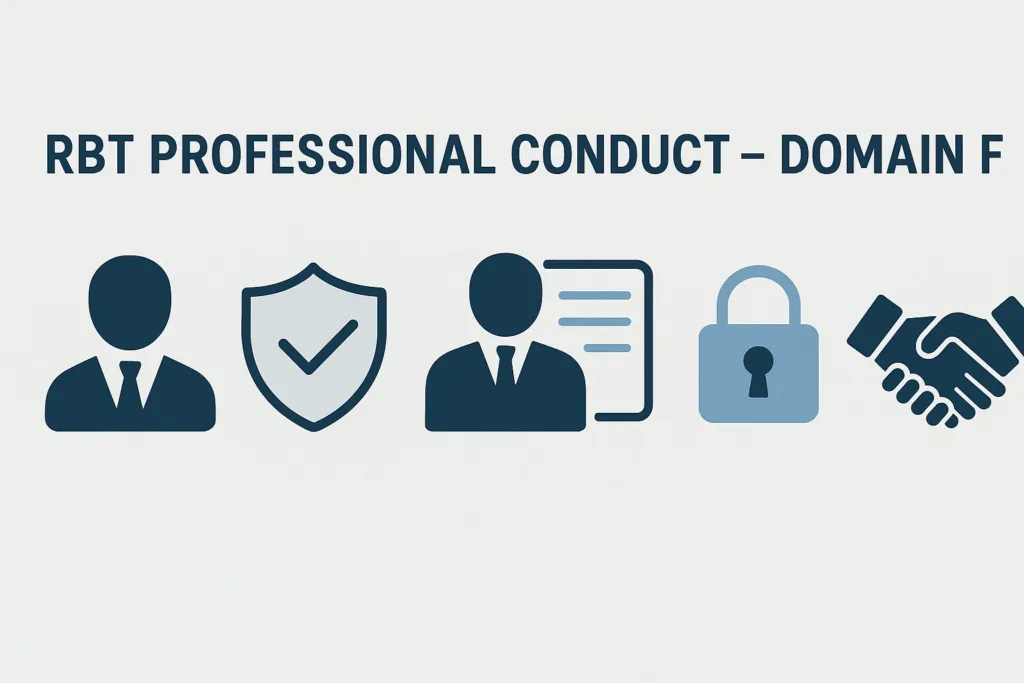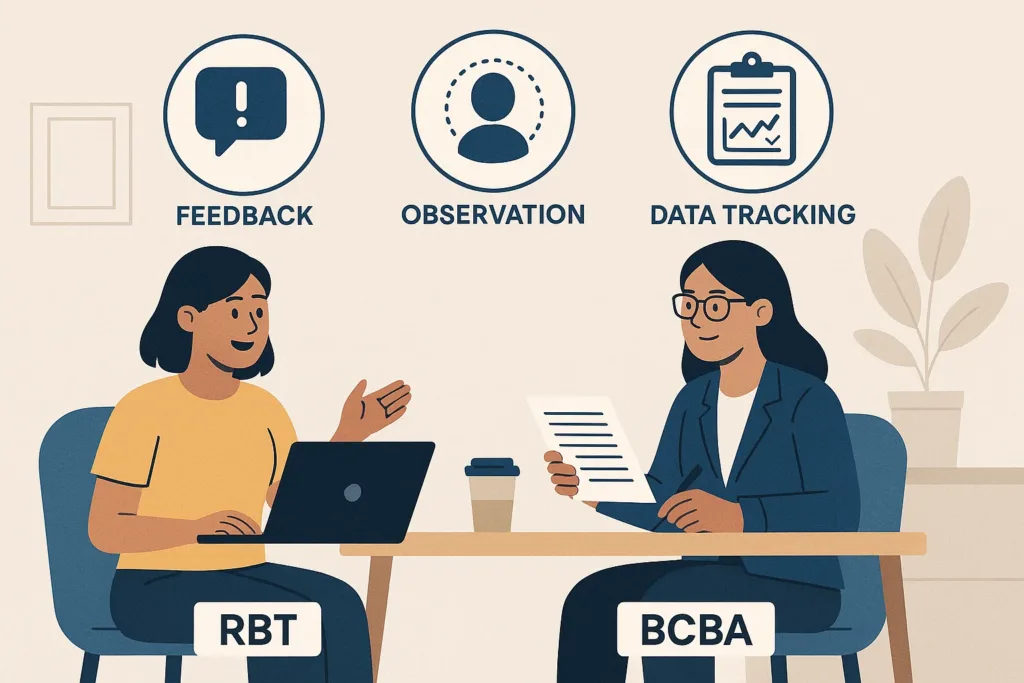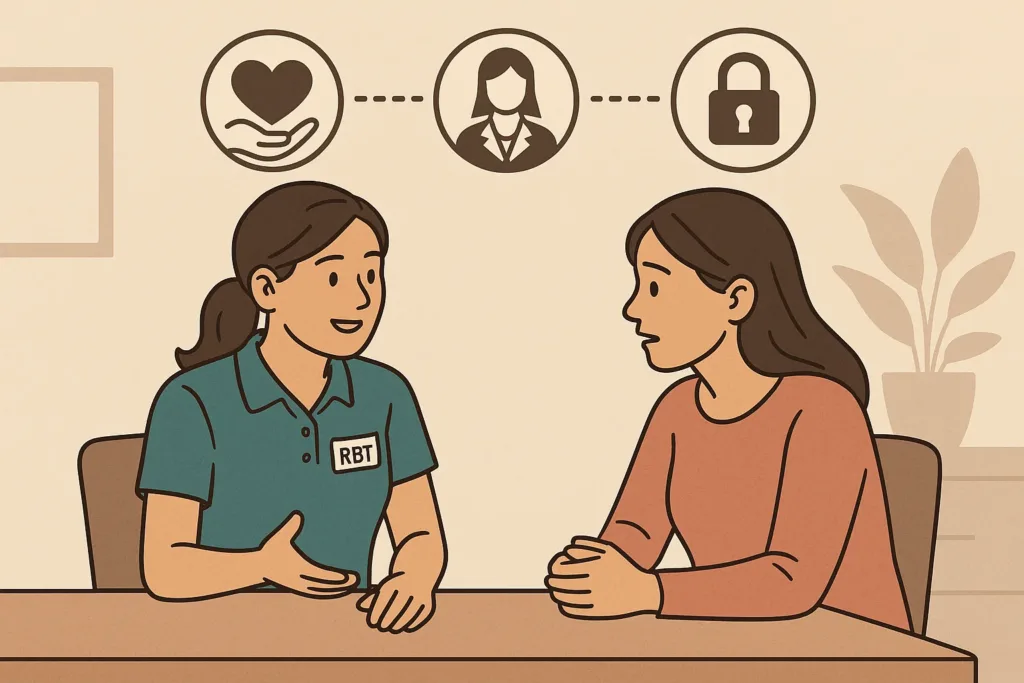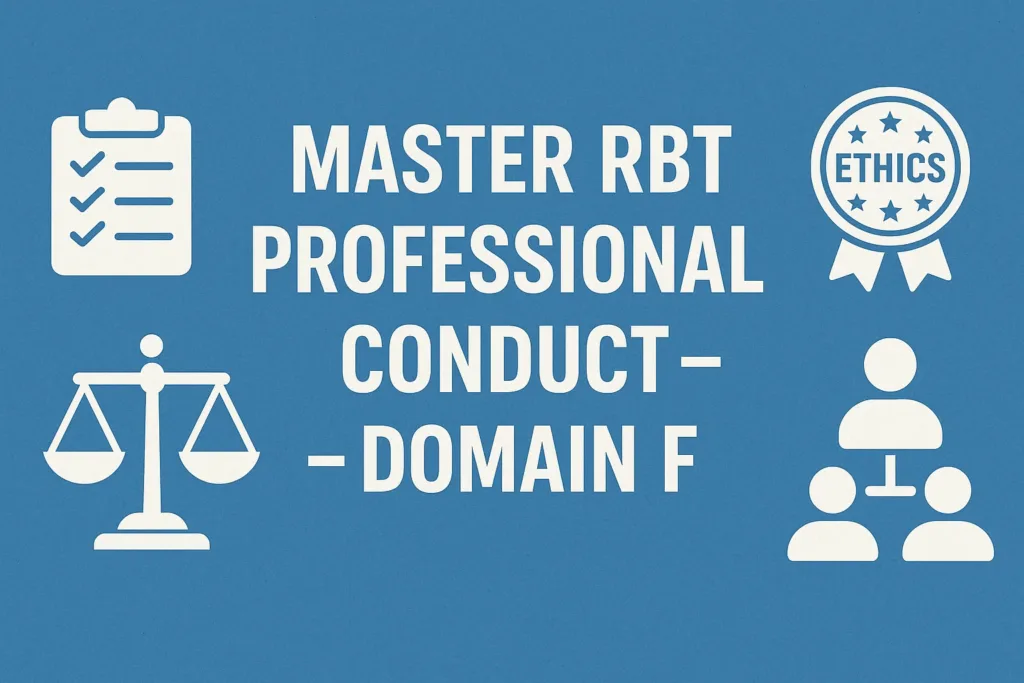RBT Professional Conduct – Domain F | Ethics & Boundaries Guide
RBT Professional conduct is the foundation of ethical and effective service delivery in Applied Behavior Analysis (ABA). As frontline providers, Registered Behavior Technicians (RBTs) are often the individuals most frequently interacting with clients and their families. Because of this, maintaining ethical boundaries, seeking proper supervision, and respecting client dignity are not optional — they are fundamental expectations of the RBT role.
Domain F of the RBT Task List (2nd edition) focuses entirely on professionalism, ethical decision-making, and appropriate conduct within the scope of the RBT’s responsibilities. These five task items (F-1 to F-5) address everything from understanding supervision requirements to how RBTs communicate, accept feedback, and manage interactions with clients and caregivers. Mastering this domain not only protects the client but also safeguards the RBT from legal, ethical, or professional consequences.

Table of Contents
F-1: Describe the BACB’s RBT Supervision Requirements and the Role of RBTs in the Service-Delivery System
All RBTs must operate under the ongoing supervision of a qualified behavior analyst — typically a Board Certified Behavior Analyst (BCBA) or Board Certified Assistant Behavior Analyst (BCaBA). RBTs do not design behavior plans, conduct assessments, or make clinical decisions independently. Their role is to implement behavior-analytic services under supervision and to report on progress or issues as they arise. The standards in Domain F align with the BACB Ethics Code for Behavior Analysts, which outlines expectations for ethical behavior and professionalism.

Supervision requirements include:
- At least 5% of the RBT’s total hours per month must be supervised
- Supervision must occur at least twice per month
- At least one session per month must include client observation
- Supervision must include real-time interaction (e.g., live, via video, or in person)
Example: If an RBT works 80 hours in a month, a minimum of 4 hours must be supervised. This may include direct observation, feedback sessions, or review of documentation. You can find specific expectations regarding supervised hours, feedback, and documentation in the BACB RBT Supervision Guidelines.
RBT responsibilities include:
- Knowing their supervisor and how to contact them
- Keeping accurate logs of supervision hours
- Following through with supervisor instructions
- Never working independently without clinical oversight
Common ethical mistakes:
- Assuming tasks that fall outside of the RBT’s scope (e.g., modifying treatment goals)
- Not informing the supervisor about schedule changes that affect service delivery
- Failing to log supervision hours properly
F-2: Respond Appropriately to Feedback and Maintain or Improve Performance Accordingly
Receiving constructive feedback is a regular part of professional growth in ABA. Supervisors observe RBTs to ensure the fidelity of intervention implementation and provide guidance for improvement. RBTs are expected to respond to feedback with professionalism, openness, and a willingness to learn.

Appropriate responses to feedback include:
- Asking questions for clarification
- Implementing changes immediately
- Following up to confirm understanding
- Reflecting on how the feedback aligns with client outcomes
Example: A supervisor observes that the RBT is waiting too long to deliver reinforcement after correct responses. The RBT thanks the supervisor, asks if using a clicker could help reduce delay, and implements the change in the next session.
Tips for success:
- Take notes during feedback sessions
- Avoid becoming defensive or dismissive
- Practice implementing changes and request follow-up feedback
Common pitfalls:
- Ignoring or resisting supervisor input
- Arguing or justifying mistakes instead of learning from them
- Making the same error repeatedly without requesting additional training
Responding well to feedback isn’t just about professionalism — it directly improves service quality and client outcomes. Responding to feedback is not just a soft skill, it’s a core indicator of RBT professional conduct. All RBT services must occur under appropriate RBT supervision, with clear documentation of hours and feedback. Professional conduct often overlaps with legal documentation and session reporting — see our Documentation & Reporting module (E-1 to E-5) for how to handle these responsibilities.
F-3: Communicate with Stakeholders (e.g., Family, Caregivers, Other Professionals) as Authorized
Domain F focuses on the foundational components of RBT ethics, including supervision, communication, and client protection. Communication with stakeholders — such as parents, teachers, caregivers, or therapists — plays a major role in the success of ABA interventions. However, as an RBT, it’s important to remember that your role is limited to implementing and reporting, not interpreting data, giving clinical recommendations, or adjusting the behavior plan.

Stakeholder communication must be:
- Authorized by your supervising BCBA
- Professional, respectful, and confidential
- Objective and factual, not opinion-based
Example: A parent asks the RBT if they can reduce therapy hours because their child seems tired. The RBT responds, “I can’t make that decision, but I’ll be sure to let your BCBA know right away.” This response shows professionalism, respects boundaries, and maintains the RBT ethics standard of referring all clinical questions to the supervisor.
Practical communication guidelines:
- Stick to session updates (e.g., “Today we worked on asking for help”)
- Avoid giving advice or commenting on plan effectiveness
- Never discuss client progress or diagnoses beyond your scope
Common mistakes to avoid:
- Offering personal opinions on behavior (“She’s just being stubborn today”)
- Making promises or adjustments without approval
- Speaking in ways that suggest clinical authority
By keeping communication clean, authorized, and in alignment with supervision, you protect yourself, the client, and the clinical integrity of the program. Ethical service delivery starts with accurate client assessment — see our Assessment module (B-1 to B-3) for your role in supporting clinical evaluations.
F-4: Maintain Professional Boundaries (e.g., Avoid Dual Relationships, Conflicts of Interest, Social Media Contacts)
As an RBT, you will build rapport and form bonds with clients and families. However, maintaining professional boundaries is non-negotiable. It ensures objectivity, prevents ethical violations, and supports client dignity. Avoiding dual relationships in ABA ensures objectivity and protects the clinical relationship between RBTs and their clients.
What are dual relationships in ABA?
A dual relationship occurs when an RBT takes on another role outside of their professional one — such as becoming friends with a client’s family, accepting gifts, or engaging with clients on social media.

Examples of boundary violations:
- Babysitting or tutoring a client outside therapy hours
- Accepting a friend request from a client’s parent
- Sharing personal life stories during a session
Professional boundaries include:
- Keeping conversations centered on therapy
- Declining invitations to social events
- Redirecting any non-clinical contact to your supervisor
Common pitfalls:
- Confusing friendliness with friendship
- Feeling “guilty” for declining a client’s request
- Accepting gifts or favors “just once” to be polite
Maintaining professional boundaries doesn’t mean being cold — it means being respectful, consistent, and focused on the client’s therapeutic goals. Avoiding overlapping personal and professional roles is central to ethical practice—learn more about dual relationships in ABA ethics here.
F-5: Maintain Client Dignity
Dignity is a core value in Applied Behavior Analysis and in human services more broadly. RBTs must always treat clients with respect, regardless of age, ability, behavior, or communication level. This means using person-first language, seeking assent, providing choices, and protecting client privacy.

Ways to preserve client dignity:
- Speak directly to the client, not just caregivers
- Offer choices when possible (e.g., “Do you want the red or blue marker?”)
- Use age-appropriate language and materials
- Avoid talking about the client in front of them as if they aren’t present
Example: Instead of saying “He had a meltdown again,” the RBT writes, “The client displayed aggressive behavior when asked to transition, including hitting and throwing objects.” This approach is both objective and respectful.
Common dignity violations:
- Laughing at, mocking, or mimicking clients
- Ignoring client preferences or autonomy
- Using language that labels or stigmatizes (e.g., “He’s just difficult”)
Tips for RBTs:
- Think: “Would I want someone to describe me this way?”
- Treat every client interaction as an opportunity to model respect and empathy
- Remember that dignity is preserved through both words and actions
Upholding client dignity isn’t just ethical — it’s the standard for every interaction an RBT should have.
Conclusion: Why RBT Professional Conduct is the cornerstone of success

The five task items in Domain F of the RBT Task List (F-1 to F-5) aren’t just about avoiding ethical violations — they shape the trust, reliability, and professionalism of the entire ABA field. As a Registered Behavior Technician, your ability to maintain supervision, accept feedback, uphold boundaries, and preserve client dignity sets the tone for every session and reflects the values of the science you practice. Committing to RBT ethics helps ensure services align with the BACB Code and protect all parties involved.
Consistent RBT supervision improves care quality and ensures compliance with the BACB’s professional conduct guidelines. These skills ensure that clients feel respected, that families trust the process, and that supervisors can guide treatment safely and effectively. When done right, professional conduct builds a reputation of integrity — and that’s a skill as valuable as any technical procedure.
To study the entire RBT Task List in order, visit our main RBT Study Guide and explore all six domains.
Want to test your understanding of ethics, supervision, and professional boundaries? Take the Professional Conduct Practice Test (F-1 to F-5) and evaluate your readiness.
